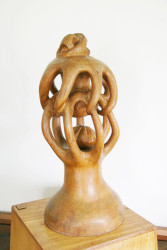Akima McPherson: Omawale Lumumba’s Galaxy I is a deceptive piece in what it seems to be saying. At first you see two forms interlocked in what seems to be a harmonious interaction. They remind of hands working together. But soon the tension contained within the form challenges that reading and this simple and straightforward work becomes full of interpretive possibilities.
Stanley Greaves: Omawale’s Galaxy is a work that is based on symmetry, which is a feature of images seen of galaxies. Interesting that he chose to express the idea as sculpture and not painting seeing that colour is a feature of galaxies. Perhaps the notion of speed and the fact of galaxies occupying space interested him. The spiral arms of the sculpture do create a sense of movement as in the spiral arms of galaxies. The small sphere locked in the centre is actually movable.
AM: I smile because you have illustrated for me why I encourage my students to connect with the work on their terms and not try to read into the work the workings of the artist’s thinking or to rely on the artist’s words or explanations in order to have a relationship with the work. I am not a ‘science person’. So when I look at Galaxy I, I don’t see the science. I see more metaphysical leanings and this is as valid as your thoughts about the work, no doubt informed by your firsthand knowledge of the artist. I see in the ‘spiral arms’ movement but also tension, as though it is attempting to undo an action of the stable hand. The lower sphere within the interlocking portion is the only form that is independent, not physically connected to the rest of the form. Consequently, I see it as a form that is simultaneously trapped and free to release itself.

SG: It is not a question of seeing Galaxy I as ‘science’. It is merely a reference point, something to start with as is the case with any creative act. The observer is free to make any kind of associations. What is perhaps necessary is for observers to have some idea of the nature of art so as to be able to respond as much as possible instead of being puzzled; “What is this all about?” An observant person, however, with little or no background in art could still make connections with things observed in nature. The spiral arms of Galaxy I for instance reminds me a bit of mangrove roots, the loose object inside becomes a kind of seed or fruit. The way to seeing the work depends on what kind of “baggage” you bring to it. The more the merrier.
AM: Yes. That’s the point I’m trying to make. I’m saying to viewers not familiar with artists and art movements, the language of art and art theory, do not feel handicapped. Use your knowledge and experiences and answer some basic questions: Do I like this work? Why? Why not? What is it saying to me? To me the artist’s explanation is irrelevant, initially. In this way they can begin to address their situation of being puzzled, if so be the case.




